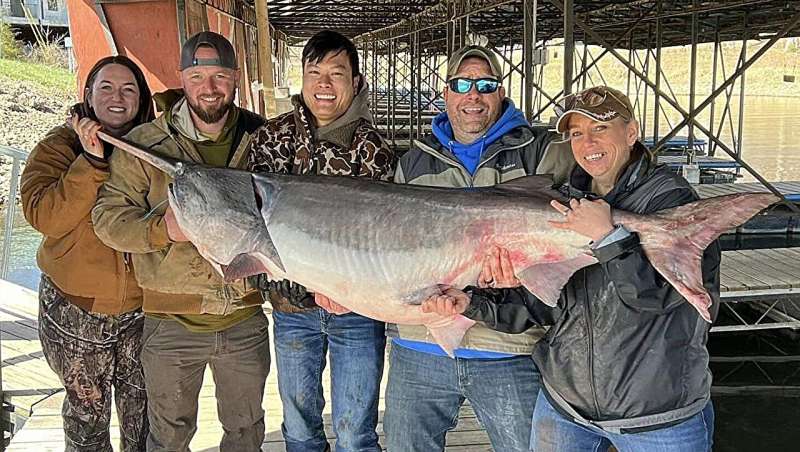This article has been reviewed according to Science X's editorial process and policies. Editors have highlighted the following attributes while ensuring the content's credibility:
fact-checked
reputable news agency
proofread
Largest fish in Missouri's records caught in Lake of the Ozarks: A 164-pound 'dinosaur'

A fisherman on the Lake of the Ozarks brought ashore a world-record paddlefish Sunday that weighed more than 164 pounds—the biggest paddlefish ever caught and the largest fish of any kind in Missouri's record books.
Chad Williams, of Olathe, Kansas, hooked the monster fish around 8:30 a.m., on an outing chartered by Smith's Fishing Adventures, based out of Warsaw.
"As soon as it hit the boat, everybody's jaws dropped," said Jason Smith, who runs Smith's Fishing Adventures. "It was an epic day for all of us."
The fish measured just over 62 inches from its eye to the fork of its tail and was caught in a roughly 10-minute tussle, said Smith, the boat captain—who called state officials to tell them about the catch. After coming ashore, the fish was weighed on a certified scale at a butcher shop in the town of Montreal, where Missouri Department of Conservation personnel met the group from the boat.
"I could not believe my eyes when I actually saw it person," said Samantha Clary, a fisheries biologist from MDC, who was there.
Paddlefish are aquatic oddities in the modern age, unlike any other fish that's still swimming—ancient relics that are considered a "living dinosaur" of the fish world, said Andrew Branson, a fisheries programs specialist for MDC. They look almost like swordfish at the front, with a long, protruding, paddle-shaped rostrum. And like sharks, they consist largely of cartilage and are covered in scale-less skin except for an area near the tail.
They are found throughout regional stretches of the Missouri and Mississippi rivers, as well as their tributaries, and have earned recognition as Missouri's "official state aquatic animal." (They are not, however, Missouri's state fish—a distinction that belongs to the channel catfish.)
In Missouri's records, the enormous specimen blew any competition out of the water—coming in 24 pounds heavier than any other recorded fish in state history. The previous record was a 140-pound paddlefish caught in 2022. And those top paddlefish have tipped the scales more than other fish caught in the state. For comparison, a Florissant man landed the largest blue catfish in Missouri's history, at 130 pounds—which was a world record at the time it was caught in 2010.
Paddlefish, also called spoonbills, are prized for their size, uniqueness and even black-market caviar. They're "filter-feeder" fish that primarily eat plankton, so they are not caught through traditional fishing methods with bait or lures. Instead, the fish are caught through snagging, when fishermen pull hooks through the water to snare them.
MDC said it was Williams' first snagging trip when he hauled in the record fish. Williams could not be reached for comment Monday.
Williams' catch now holds the record for the world's biggest paddlefish ever caught, surpassing one from Oklahoma by 13 ounces, according to MDC. And it dwarfed the paddlefish that Smith is accustomed to. Before Sunday, he said the biggest one he'd boated was 108 pounds, with keepers typically weighing between 40 and 70 pounds.
"I've been doing this for 18 years, and it's off the charts for anything I've ever seen," Smith said.
The fish was a female and full of eggs that were not close to maturity. Paddlefish of legal keeper size, such as the record-breaking fish, cannot be released in Missouri, in order to disincentivize anglers from throwing back male fish and keeping only females, whose coveted eggs can be processed into caviar that commands thousands of dollars. The black market has attracted poachers to Missouri from around the globe.
"Poaching is a big problem," said MDC's Branson. The sturgeon that are the source of eggs for famed Russian caviar have "been way overfished," fueling a hunt for alternatives like paddlefish eggs, he said.
"A lot of the world is looking to the next best thing," said Branson.
Despite the interest that paddlefish generate from poachers in the black-market caviar trade, their populations are doing well, MDC said.
An approximate age of Williams' fish was not immediately clear, but Clary, the state biologist, said that paddlefish can live up to 30 years. MDC officials took the jaw from the fish; studying its cross-sections will help them determine its age, in a way that's similar to counting tree rings.
MDC will also conduct other tests to learn more about the fish, including DNA analysis that can reveal whether it's a wild-born paddlefish or one of the many that are stocked by the state into three lakes formed behind dams: the Lake of the Ozarks, Truman Lake and Table Rock Lake.
Dams generally prevent the fish from successfully spawning in the lakes behind them because paddlefish ordinarily require different conditions to reproduce. But there is some evidence of natural paddlefish reproduction in Truman Lake, and it's possible for the fish to come downstream from Truman Lake into the Lake of the Ozarks, said Clary.
The lake-raised paddlefish tend to get bigger than their river-dwelling counterparts.
"We knew we had world-record (paddlefish) out there," Branson said. "It was just a matter of when someone was going to get one."
2024 STLtoday.com.
Distributed by Tribune Content Agency, LLC.


















